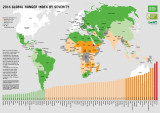environment
AGROVOC URI: http://aims.fao.org/aos/agrovoc/c_2593
Synopse Welthunger-Index 2014: Herausforderung verborgener Hunger
Der Welthunger-Index (WHI) 2014 stellt die nationale, regionale und weltweite Hungersituation zum neunten Mal in jahrlicher Folge multidimensional dar. Er zeigt, dass bei der globalen Hungerbekampfung seit 1990 Fortschritte erzielt werden konnten, jedoch angesichts sehr ernster oder gar gravierender Hungerwerte in 16 Landern noch immer groser Handlungsbedarf besteht. Der Schwerpunkt dieses Berichts liegt auf einem entscheidenden Aspekt des Hungers, der haufig ubersehen wird, dem verborgenen Hunger.
2014 Global hunger index by severity
The Global Hunger Index (GHI) is based on three equally weighted indicators: > Undernourishment: the proportion of undernourished people as a percentage of the population (reflecting the share of the population with insufficient caloric intake); > Child underweight: the proportion of children younger than age five who are underweight (that is, have low weight for their age, reflecting wasting, stunted growth, or both), which is one indicator of child undernutrition; and > Child mortality: the mortality rate of children younger than age five (partially reflecting the fatal synergy o
2011 Politiques alimentaires mondiales rapport
Depuis 2007, deux séries successives d’envolée des prix des denrées alimentaires ont causé la faim ou la malnutrition pour des millions de personnes dans le monde. Les mêmes facteurs qui avaient contribué à la hausse des prix en 2007-2008 ont refait surface en 2011 et ont pour nom : la baisse du taux de croissance de la productivité agricole, le niveau élevé du coût de l’énergie favorisant l’expansion de la production de biocarburants, la dépréciation du dollar américain, une forte demande des pays émergents en matière de produits agricoles et les bouleversements climatiques.
Synthèse l’Indice de la faim dans le monde 2014: Le défi de la faim invisible
Le rapport de l’Indice de la faim dans le monde 2014 – neuvieme edition – propose une mesure multidimensionnelle de la faim au niveau national, regional et mondial. Le GHI 2014 montre les progres effectues en matiere de reduction de la faim depuis 1990, mais des efforts restent a faire, le niveau de la faim restant alarmant voire extremement alarmant dans 16 pays. Cette annee, le GHI se concentre sur un aspect particulier de la faim souvent neglige : la faim invisible.
2014-2015 Global food policy report
This 2014–2015 Global Food Policy Report is the fourth in an annual series that provides a comprehensive overview of major food policy developments and events. In this report, distinguished researchers, policymakers, and practitioners review what happened in food policy in 2014 at the global, regional, and national levels, and—supported by the latest knowledge and research—explain why. This year’s report is the first to also look forward a year, offering analysis of the potential opportunities and challenges that we will face in achieving food and nutrition security in 2015.
Agriculture, Nutrition, and Health: Connecting the Dots
The agriculture, nutrition, and health nexus came to prominence in 2011. With 1 billion people continuing to suffer from food insecurity, and with vitamin and mineral deficiencies compromising the nutrition and health of billions of people, the international development community began to ask how much more could agriculture do to improve human wellbeing if it explicitly included nutrition and health goals?
2012 Politiques alimentaires mondiales rapport: Aperçu
This 2012 Global Food Policy Report is the second in an annual series that provides an in-depth look at major food policy developments and events. Initiated in response to resurgent interest in food security, the series offers a yearly overview of the food policy developments that have contributed to or hindered progress in food and nutrition security. It reviews what happened in food policy and why, examines key challenges and opportunities, shares new evidence and knowledge, and highlights emerging issues.
New Players: Stepping into the Global Food System
2012 Global food policy report: Overview
This 2012 Global Food Policy Report is the second in an annual series that provides an in-depth look at major food policy developments and events. Initiated in response to resurgent interest in food security, the series offers a yearly overview of the food policy developments that have contributed to or hindered progress in food and nutrition security. It reviews what happened in food policy and why, examines key challenges and opportunities, shares new evidence and knowledge, and highlights emerging issues.
Agriculture and climate change: Direct and indirect mitigation through tree and soil management
Many opportunities exist for mitigating greenhouse gas (GHG) emissions through better management of trees and soils. There is potential for both direct mitigation through better management of carbon in agricultural landscapes and indirect mitigation through reduced pressure on carbon stored in forests, peatlands, and wetlands. Effectively harnessing these opportunities will take bold action in climate change negotiations.












